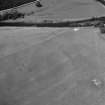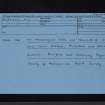Canonbie Priory
Priory (Medieval)
Site Name Canonbie Priory
Classification Priory (Medieval)
Alternative Name(s) Halgreen; Hallgreen; 'house Of Liddel'; Park House
Canmore ID 67847
Site Number NY47NW 4
NGR NY 40011 75884
Datum OSGB36 - NGR
Permalink http://canmore.org.uk/site/67847
- Council Dumfries And Galloway
- Parish Canonbie
- Former Region Dumfries And Galloway
- Former District Annandale And Eskdale
- Former County Dumfries-shire
NY47NW 4 4000 7588
See also NY37NE 6.
(NY 4000 7588) Site of Priory (NR) (Augustinian)
OS 6" map (1957)
Founded by Turgot de Rossedal temp. David I (1124-53) and subsequently a cell of Jedburgh. Dissolved by Henry VIII in 1544. The Site, 1/2 mile SSE of the parish church, was secularized in 1606, and the buildings demolished before 1620.
Very few pieces of the building are now extant but the sedilia was transferred between 1815-1854 to the present churchyard at NY 394 622.
RCAHMS 1920; D E Easson 1957; J and R Hyslop 1912
No trace of the priory survives. The site falls in an arable field. The alleged sedilia now forms part of the Rev. James Donaldson's tomb at NY 3943 7622.
Visited by OS (RD) 18 December 1970.
Field Visit (October 1980)
Canonbie, Priory NY 400 758 NY47NW 4
The Augustininan 'house of Liddel' is said to have stood 470m SSE of the modern farmhouse of Park House. In about 1168 it was granted to Jedburgh Abbey by Turgis de Rosdale and in 1544 it was suppressed by Henry VIII. What was probably part of a sedilia from the priory is built into a tomb situated near the E side of the parochial burial ground (NY 394 762).
RCAHMS 1981, visited October 1980
(MacGibbon and Ross 1896-7, iii, 431; Cowan and Easson 1976, 90; NMRS, DF/26)
Geophysical Survey (1993)
NY47NW 4 4000 7588
A preliminary geophysical survey of this site was carried out by GeoQuest in November 1993 on behalf of RCAHMS. A number of geomagnetic anomalies were revealed, but the absence of any clearly identifiable building remains suggests that the survey did not encompass the main focus of archaeological activity associated with the Abbey.
GeoQuest 1993 (MS/730/12).
Field Visit (15 October 1994)
NY47NW 4 4000 7588
There are no visible remains of the Augustinian priory of Canonbie. Geophysical survey carried out in the area indicated as the site of the priory on the 1st edition of the OS 6-inch map (Dumfriesshire, sheet liii, 1862) proved inconclusive, revealing only a number of linear features (probably ditches or drains), several areas of enhanced magnetic susceptibility (possibly indicating hearths, kilns, concentrations of slag, or natural igneous material), and some disturbance. These results suggest that if the priory lay within this area, its buildings have been comprehensively robbed.
The priory known as 'the religious house of Liddel' was established as a dependency of Jedburgh by Turgis de Rosedale and, with its adjacent lands, confirmed to the abbey of Jedburgh by William I between 1165 and 1170. Guy of Rosedale, with the consent of his son Ralph, granted the priory 42 acres between the Esk and the Liddel at their confluence and free fishing from the 'ditch of Liddel' to the church of Liddel.
Thereafter, little or nothing is known of the history of the priory until the Reformation. In 1544 Henry VIII ordered its suppression, claiming that it lay within the 'Debatable land', and it was 'destroyed' by English forces after the battle of Solway Moss. In 1587 the priory and its lands became the property of the Crown and were erected, along with Jedburgh Abbey, into a temporal lordship for Alexander Home in 1606, by which date little of the priory buildings seem to have survived.
In 1795 it was stated that 'some ruins of the convent are still to be seen at Halgreen' and that 'part of the old wall of the church still remains, to which a modern building is united; and in which is preserved a small arch'. This 'small arch' is probably to be identified with the head of the doorway or sedillia that was re-erected in the parish churchyard in the 19th century. The small settlement of Halgreen no longer exists, although the footings of one of its cottages may still be seen.
Visited by RCAHMS (IMS), 15 October 1994.
J and R Hyslop 1912; I B Cowan and D E Easson 1976; Reg Reg Scot; NMRS, MS/730/12.
Listed as priory.
RCAHMS 1997.




















